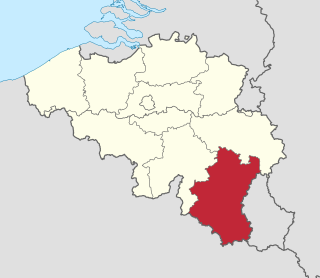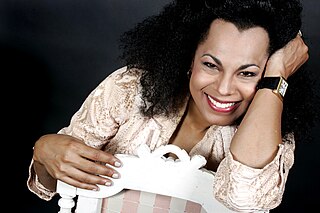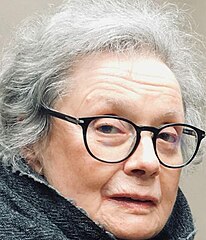
Jacqueline Harpman was a Belgian writer who wrote in French.

The Royal Theatre of La Monnaie is an opera house in central Brussels, Belgium. The National Opera of Belgium, a federal institution, takes the name of this theatre in which it is housed—La Monnaie in French or De Munt in Dutch—referring both to the building as well as the opera company. As Belgium's leading opera house, it is one of the few cultural institutions to receive financial support from the Federal Government of Belgium. Other opera houses in Belgium, such as the Vlaamse Opera and the Opéra Royal de Wallonie, are funded by regional governments.

Prince Charles, Count of Flanders was a member of the Belgian royal family who served as regent of Belgium from 1944 until 1950, while a judicial commission investigated his elder brother, King Leopold III of Belgium, as to whether he betrayed the Allies of World War II by an allegedly premature surrender in 1940 and collaboration with the Nazis during the occupation of Belgium. Charles' regency ended when Leopold was allowed to return to Belgium. Shortly after returning and resuming his monarchical duties, Leopold abdicated in favour of his son, Baudouin.

Racing White Daring Molenbeek Brussels F.C., often simply referred to as RWDM Brussels, F.C. Brussels or simply Brussels, was a Belgian professional association football club based in the municipality of Molenbeek, in the Brussels Capital-Region. They last played in the second division during the 2013–14 season where they finished 8th, but folded at the end of the season due to financial trouble. The club was a continuation of FC Strombeek, a club from the Brussels suburb of Strombeek-Bever with matricule №1936 which was formed in 1932. However, Strombeek merged with Racing White Daring Molenbeek (RWDM) in the 2000s and practising the tradition of RWDM instead. FC Brussels played at the Stade Edmond Machtens, Molenbeek's former stadium. Their highest league ranking was a 10th place in the first division in 2005–06.

Prince Lorenz of Belgium, Archduke of Austria-Este is a member of the Belgian royal family as the husband of Princess Astrid of Belgium. He is the head of the House of Austria-Este, a cadet branch of the House of Habsburg-Lorraine; he has held this position since 1996.

The Brussels Stock Exchange, abbreviated to BSE, was founded in Brussels, Belgium, by decree of Napoleon in 1801. In 2002, the BSE merged with the Amsterdam, Lisbon and Paris stock exchanges into Euronext, renaming the BSE Euronext Brussels. The most well known stock market index on the BSE is the BEL20.
Johan Capiot is a Belgian former professional road racing cyclist. He was a professional rider from 1986 to 2000. His son Amaury is also a professional cyclist.

Adelbert Van de Walle (1922–2006) was a Flemish-Belgian architect, art historian and professor in the History of Art and Archaeology at the University of Ghent (UGent).
Stephen Desberg is a Belgian writer of comics. In 2010, he was the 10th bestselling author of comics in France, with 412,000 copies of all his comics together sold that year.

RCP Design Global or RCP is an independent design agency based in Tours and Paris (France) founded by Régine Charvet-Pello in 1986. RCP is predominantly based in the transport and mobility design, and specialises in urban transport, High-speed rail, interiors, public spaces and street furniture. RCP is the French leader on sensory design.
RSC Anderlecht Féminin is a Belgian women's football team, currently playing at the Super League Vrouwenvoetbal. It formerly played the Belgian First Division and the BeNe League, that was folded in 2015. The team was founded in 1971 as Brussels Dames 71.

Philippe Neerman (1930–2011) was a Belgian industrial designer and President of Industrial Design Planning Office Philippe Neerman & Co. N.V.\S.A. He was known for his application of ergonomics in public transportation systems and his work on major projects such as the Royal Library of Belgium, the Royal Castle of Laeken, and the Royal Palace of Brussels. He also participated in the international Design Biennale Interieur in Courtray, Belgium. He mainly focused on transportation and made designs for metros and trams including the Euro Tram, the Brussels Metro, and the Metro in Barcelona. His work has been incorporated into a diverse collection of museums, including the Ghent Design Museum.

Jacqueline Galant is a Belgian politician from the Mouvement Réformateur. She was the Minister of Mobility, responsible for Belgocontrol and the National Railway Company of Belgium, in the federal Belgian Michel Government from 11 October 2014 until she resigned on 15 April 2016 in the wake of the 2016 Brussels bombings. She remains the mayor of Jurbise.

The Isabelle Gatti de Gamond Royal Atheneum is a French-speaking K-12 school located in Brussels, Belgium. When founded in 1864 by Isabelle Gatti de Gamond, the school was the first non-confessional school for girls in Belgium.
Christine De Smedt is a Belgian dancer and choreographer. Her artistic work is situated on the boundary between dance / performance, choreography, artistic coordination and artistic projects of various kinds.

Luxembourg is one of the 11 multi-member constituencies of the Chamber of Representatives, the lower house of the Belgian Federal Parliament, the national legislature of Belgium. The constituency was established as Arlon-Marche-Bastogne-Neufchâteau-Virton in 1995 following the fourth Belgian state reform. It was renamed Luxembourg in 2003 following the re-organisation of constituencies across Belgium along provincial lines. It is conterminous with the province of Luxembourg. The constituency currently elects four of the 150 members of the Chamber of Representatives using the open party-list proportional representation electoral system. At the 2019 federal election the constituency had 212,441 registered electors.

Renny Ramakers is a Dutch art historian, curator, design critic, and co-founder and director of the Droog design foundation. Ramakers writes articles, gives lectures, initiates projects and curates exhibitions in the field of art and design. In 2007 she was awarded the Benno Premsela Prize, in 2019 the IJprijs for her cultural contribution to the city of Amsterdam, and in 2018 she received a Dutch Royal Award for her work in the field of Dutch Design.

Isabelle Kabatu is a Belgian operatic soprano with a father from Belgian Congo and a Belgian mother. She has appeared internationally, with a focus on the Italian repertoire such as Verdi's La traviata and Aida, and Puccini's Manon Lescaut and Tosca. She appeared as Bess in Gershwin's Porgy and Bess beginning at the Houston Grand Opera and touring the world. In 2012, she appeared in the world premiere of Franck's early work Stradella.

Jacqueline Mesmaeker was a Belgian artist who worked in plastic. She died on 7 December 2023, at the age of 93.































